Choosing the right clothing materials is essential for comfort and performance, particularly when considering factors like breathability, moisture-wicking properties, and durability. Breathable fabrics such as cotton and linen promote air circulation, while moisture-wicking technologies keep you dry during physical activities. Additionally, durable materials like nylon and Gore-Tex ensure your clothing can withstand the rigors of outdoor adventures.
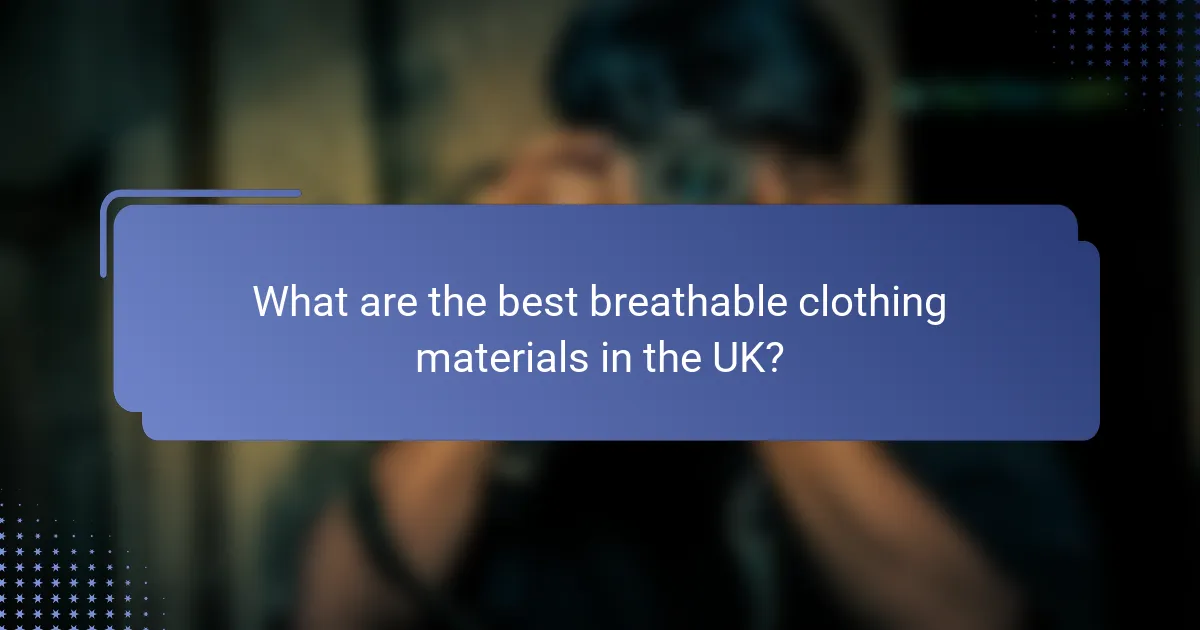
What are the best breathable clothing materials in the UK?
The best breathable clothing materials in the UK include cotton, linen, merino wool, bamboo fabric, and polyester blends. These materials allow for air circulation and moisture management, making them ideal for comfort in various weather conditions.
Cotton
Cotton is a popular choice for breathable clothing due to its natural fibers that allow air to flow freely. It absorbs moisture well, making it comfortable to wear in warm weather, though it can retain dampness if not dried properly.
When selecting cotton garments, look for lightweight options or those labeled as “percale” or “sateen” for enhanced breathability. Avoid heavy cotton fabrics if you need maximum airflow.
Linen
Linen is known for its exceptional breathability, making it perfect for hot climates. Its loose weave allows air to circulate, keeping the body cool and dry.
Consider linen clothing for summer wear, but be mindful that it wrinkles easily. Look for blends with cotton or polyester for improved durability while maintaining breathability.
Merino wool
Merino wool is surprisingly breathable and moisture-wicking, making it suitable for both warm and cool conditions. It helps regulate body temperature and can absorb moisture without feeling wet.
Choose lightweight merino wool garments for active wear or layering. They are often more expensive, but their durability and comfort make them a worthwhile investment.
Bamboo fabric
Bamboo fabric is another breathable option, known for its softness and moisture-wicking properties. It is naturally antibacterial, which helps reduce odors, making it ideal for active wear.
When purchasing bamboo clothing, look for blends that include cotton or spandex for added stretch and durability. Ensure the fabric is sustainably sourced for an eco-friendly choice.
Polyester blends
Polyester blends can offer good breathability and moisture-wicking capabilities, especially when combined with natural fibers. These blends are often lightweight and quick-drying, making them suitable for athletic wear.
Check for garments labeled as “moisture management” or “performance fabric” for optimal breathability. Be cautious of 100% polyester options, as they may not provide the same comfort level as blended fabrics.
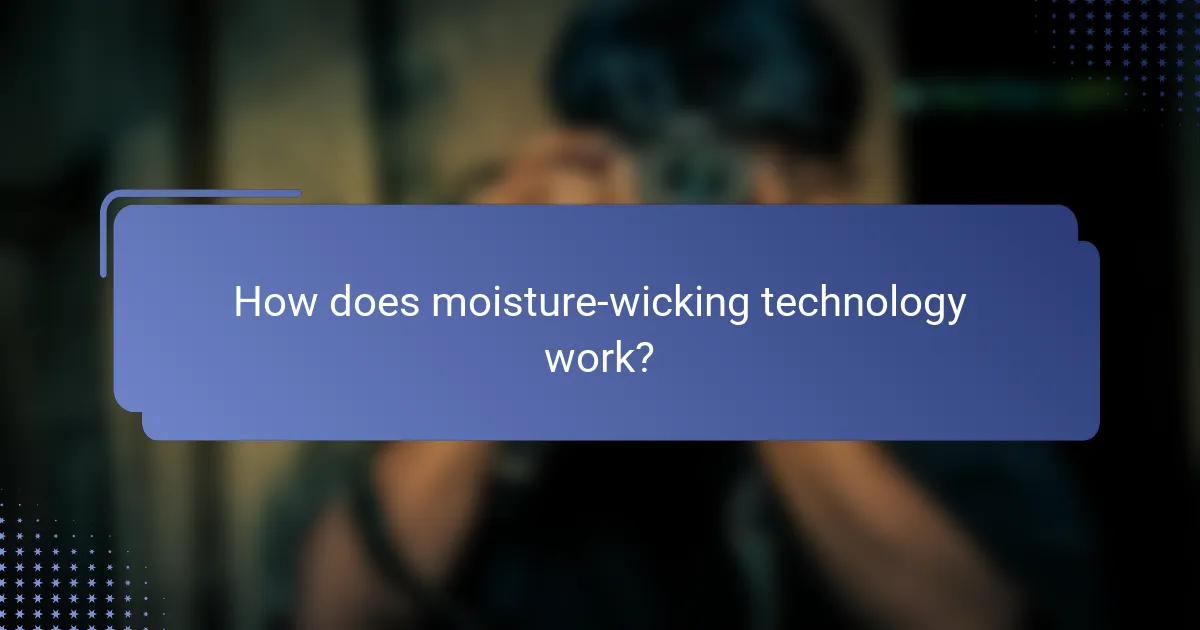
How does moisture-wicking technology work?
Moisture-wicking technology works by drawing sweat away from the skin to the fabric’s surface, where it can evaporate quickly. This process helps keep the wearer dry and comfortable during physical activities.
Capillary action
Capillary action is the primary mechanism behind moisture-wicking fabrics. It occurs when liquid moves through narrow spaces within the material, allowing sweat to be pulled away from the skin. This movement is facilitated by the fabric’s structure, which often features tiny channels that enhance moisture transport.
In practical terms, fabrics designed for capillary action can significantly improve comfort during exercise. For instance, a shirt made from such materials can help maintain a cooler body temperature by efficiently managing sweat.
Fabric composition
The composition of moisture-wicking fabrics typically includes synthetic fibers like polyester or nylon, which are known for their hydrophobic properties. These materials repel water, allowing sweat to move through the fabric rather than soaking in.
Some blends may incorporate natural fibers, but the effectiveness of moisture-wicking is often reduced. When selecting clothing, look for labels that specify moisture-wicking technology to ensure optimal performance.
Performance fabrics
Performance fabrics are engineered specifically for athletic use, combining moisture-wicking properties with other features like breathability and stretch. These fabrics often undergo treatments to enhance their ability to manage moisture and resist odors.
When choosing performance apparel, consider factors such as weight, fit, and intended use. Lightweight fabrics are ideal for high-intensity activities, while heavier options may provide more warmth for cooler conditions. Always check product specifications to ensure they meet your activity needs.
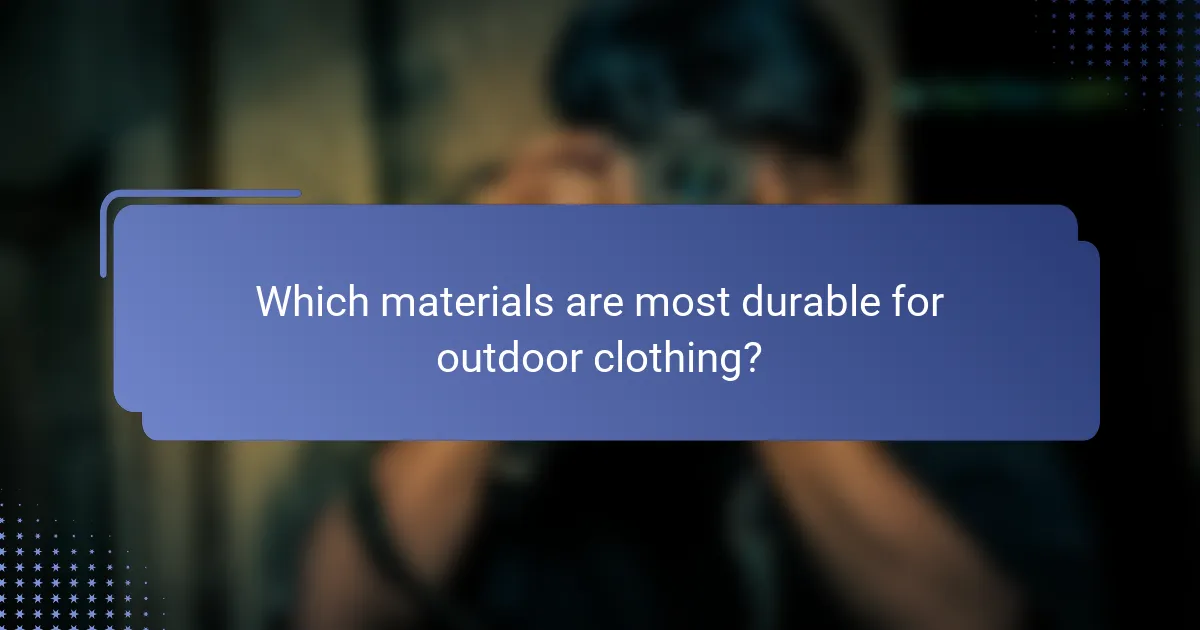
Which materials are most durable for outdoor clothing?
Durability in outdoor clothing is primarily determined by the material’s ability to withstand wear, tear, and environmental factors. Key materials known for their durability include nylon, polyester, Gore-Tex, and canvas, each offering unique benefits suited for various outdoor activities.
Nylon
Nylon is a synthetic fabric renowned for its strength and resilience, making it a popular choice for outdoor gear. It is lightweight yet incredibly durable, often used in jackets, backpacks, and tents. When selecting nylon clothing, look for ripstop variations, which feature a grid pattern that enhances tear resistance.
However, nylon can absorb moisture, which may lead to discomfort in humid conditions. To mitigate this, consider nylon blends that incorporate moisture-wicking properties for better performance during physical activities.
Polyester
Polyester is another widely used synthetic material known for its durability and quick-drying capabilities. It resists shrinking and stretching, making it ideal for outdoor clothing that needs to maintain its shape over time. Polyester is often used in activewear and outer layers due to its ability to wick moisture away from the skin.
When choosing polyester garments, look for high-denier fabrics, which indicate a thicker, more durable weave. This can enhance the longevity of the clothing, especially in rugged outdoor environments.
Gore-Tex
Gore-Tex is a specialized fabric that combines durability with waterproof and breathable properties, making it ideal for extreme weather conditions. It features a membrane that prevents water from entering while allowing sweat vapor to escape, keeping the wearer dry and comfortable.
While Gore-Tex garments tend to be more expensive, their performance in harsh conditions often justifies the investment. Look for products with reinforced seams and additional features like adjustable hoods and cuffs for enhanced protection.
Canvas
Canvas is a heavy-duty fabric made from cotton or synthetic fibers, known for its exceptional durability and resistance to wear. It is commonly used in outdoor gear such as tents, backpacks, and workwear. Canvas can withstand rough handling and is often treated for water resistance, making it suitable for various outdoor activities.
However, canvas can be heavier and less breathable than other materials, so it may not be ideal for high-intensity activities. When selecting canvas clothing, consider options with ventilation features or lighter weights for improved comfort during extended use.
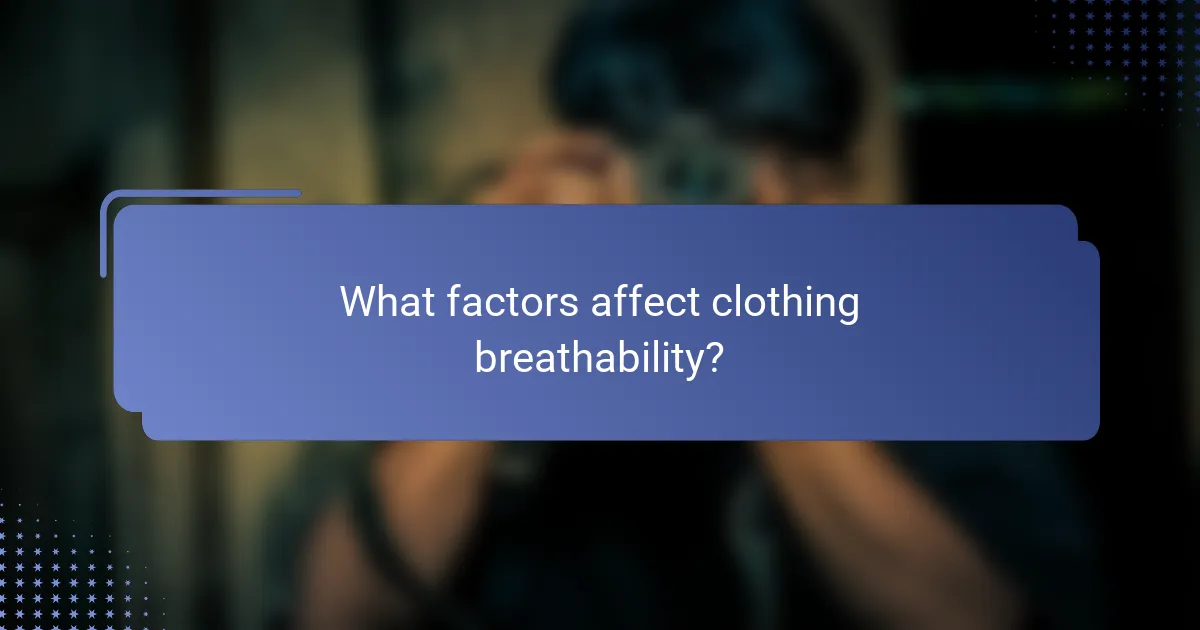
What factors affect clothing breathability?
Clothing breathability is influenced by several key factors, including fabric thickness, weave structure, and moisture management. Understanding these elements can help you choose the right materials for comfort and performance in various conditions.
Fabric thickness
Fabric thickness plays a significant role in breathability. Thinner fabrics generally allow more air circulation, making them suitable for warm weather or high-intensity activities. However, very thin materials may sacrifice durability and coverage.
When selecting clothing, consider that fabrics with a thickness of around 100-200 grams per square meter (gsm) are often breathable yet durable. For cooler climates, slightly thicker fabrics may be necessary, but they should still maintain some level of airflow.
Weave structure
The weave structure of a fabric affects how well it breathes. Looser weaves create more space for air to pass through, enhancing ventilation. In contrast, tightly woven fabrics may trap heat and moisture, leading to discomfort.
Common weave types include plain, twill, and satin. Plain weaves are typically more breathable than satin weaves, making them ideal for active wear. Look for fabrics that feature an open weave for maximum airflow.
Moisture management
Moisture management is crucial for maintaining breathability in clothing. Fabrics that wick moisture away from the skin help keep you dry and comfortable, especially during physical activities. Materials like polyester and merino wool are known for their excellent moisture-wicking properties.
When choosing moisture-wicking clothing, check for features like hydrophilic finishes or specialized blends designed to enhance moisture management. This can significantly improve comfort levels during workouts or in humid conditions.
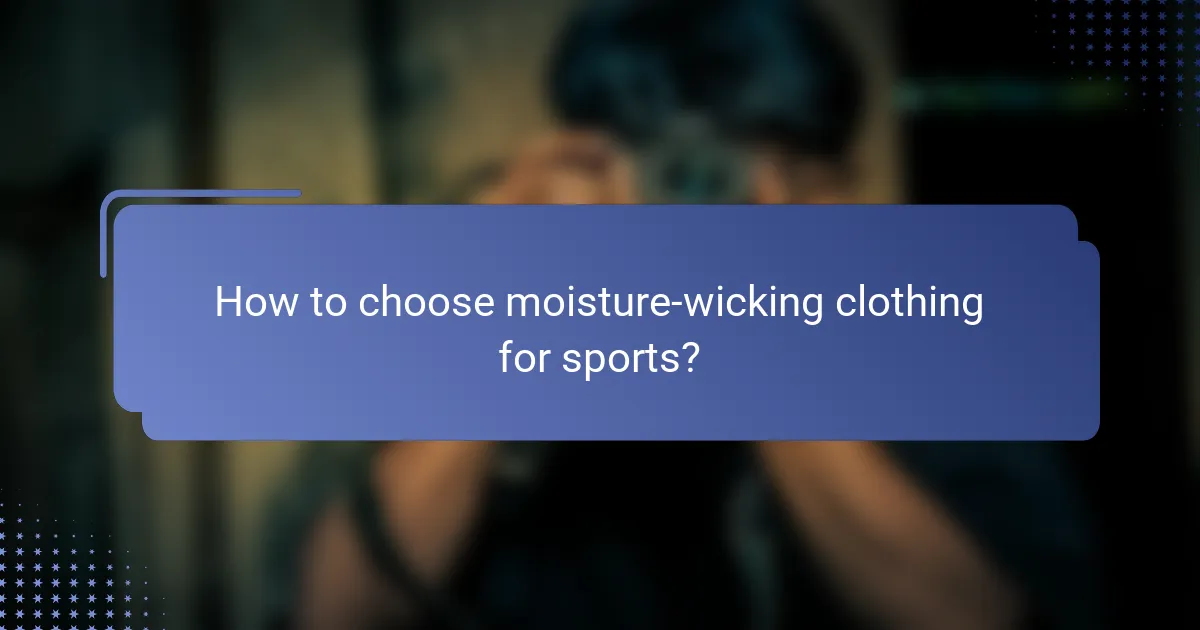
How to choose moisture-wicking clothing for sports?
To choose moisture-wicking clothing for sports, prioritize fabrics designed to pull sweat away from your skin, keeping you dry and comfortable during physical activity. Look for materials that offer breathability and quick-drying properties to enhance your performance.
Fabric type
When selecting moisture-wicking clothing, consider synthetic fabrics like polyester, nylon, and blends that are engineered for performance. These materials are effective at drawing moisture away from the body and drying quickly, making them ideal for high-intensity sports.
Natural fibers like merino wool can also be moisture-wicking, but they may not dry as quickly as synthetics. If you prefer natural options, look for lightweight merino blends that offer both breathability and moisture management.
Fit and comfort
The fit of moisture-wicking clothing significantly affects its performance. Opt for a snug yet comfortable fit that allows for a full range of motion without being restrictive. Loose clothing may trap moisture against your skin, reducing the effectiveness of the moisture-wicking properties.
Additionally, consider features like flat seams and tagless designs to minimize chafing during workouts. Test different styles to find what feels best for your body type and activity level, ensuring that comfort is a priority in your selection process.



